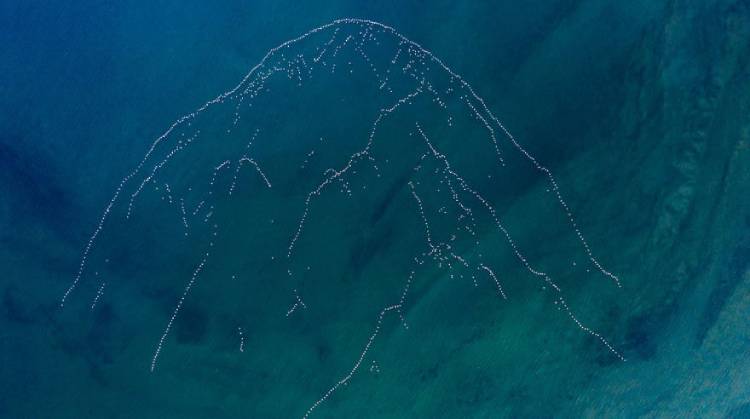The best images of the BigPicture nature photography competition in 2020
The seventh edition of the BigPicture photography competition was held, and the winners’ names were announced.
Every year, these competitions are held among photographers from all over the world. The theme of this year’s competition was to depict nature, animal, and plant species and the importance of protecting them.
The California Academy of Sciences held the seventh edition of the BigPicture Nature Photography Contest this year. In this competition, photographers from around the world were asked to submit images that depict the rich diversity of species on Earth and, using the power of imagination, encourage the viewer to protect and preserve these species.
Now, with the end of this year’s competition deadline, the selected photos have been published in the biographic online magazine. This magazine writes about science and the optimal use of resources and is the main sponsor of this photography competition series. Below some photos there are descriptions written by this magazine. In the following, we review the top images in order.
1. First Prize Winner: Bunny Ball – Photographer: Andy Parkinson
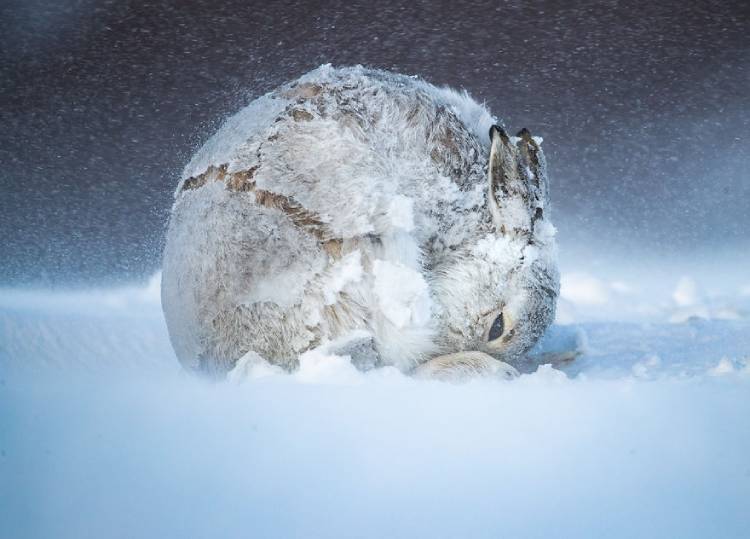
Andy Parkinson won the first prize in this tournament. Interestingly, before photographing this mountain hare, he endured weeks of extreme cold, and ice shards scarred his face. As you can see in the photo, this rabbit is curled up against the Scottish winter storm.
It should be said that this type of native British rabbit is in such difficult conditions in their homes. Every winter, groups of twenty or more of these rabbits move to slopes with less snow to feed on plants. Before settling down, they jump around the trail to confuse predators.
When the storm started, this female rabbit built her shelter to protect herself from the battery and lowered her head into a ball to keep warm and shrink herself to defend herself from the blows of ice and cold. This rabbit uses a clever strategy to defend itself, while other animals go into the shelter or the basement.
Despite being agile and fast, mountain hares are endangered due to poachers and habitat loss. Parkinson hopes the photo will inform lawmakers to protect these rabbits. Hares are becoming extinct faster than any other British mammal species.
BigPicture Contest winners have been well rewarded for their efforts. The winner of the first prize, which was selected as the best photo of this competition, received an award of five thousand dollars,. That photo will be displayed at the annual exhibition of the California Academy of Sciences.
This competition had seven thematic sections, which are: “Nature Art,” “Aquatic,” “Winged Creatures,” “Landscapes, Seascapes and Plants,” “Terrestrial Wildlife,” “Man/Nature,” and “Illustrated Story”. . The first winner of each of these categories was awarded a cash prize of one thousand dollars, and their photos will be displayed in the exhibition of the year. Except for the illustrated story section, certificates were awarded to 6 finalists of each category. In the defined story category, only the first person won a prize.
2. Illustrated Story Winner: Coexistence of Guardian Warriors – Photographer: Amy Vitali

According to Amy Vitali, humans whose lives are connected to the natural world are often overlooked in nature photography. The photographer worked on a project documenting the relationship between the Samburu people and wildlife in northern Kenya to change the perception that separates humans from nature photography. This documentary, which lasted ten years, tells the story of the Samburu people who support wildlife and their habitat.
Considering that these people feed on animals, it may seem that their lives are in contrast with elephants, rhinoceroses, giraffes, and other large mammals living in the same habitat. In recent decades, poachers have taken a toll on elephants, and herders say their herds of cattle have also suffered.
Elephants help the grass grow by cutting grass and small trees. So when the number of elephants decreases, less grass grows to feed the cows. To this end, the Sambaros have built shelters to protect the elephants from poachers. They also work to protect other endangered species, such as the Somali giraffe. You can see this type of giraffe in the picture above.
The recent actions of the Samburu people have changed their previous behavior towards wildlife and show how closely related the health of humans and animals are. In this regard, Vitali says: “Due to the health of these wildlife species, the amount of illegal hunting has decreased significantly.”
Rhonda Rubinstein, the co-founder of BigPicture and director of innovation at the California Academy of Sciences, said of this year’s photography contest:
As usual, we received exciting photos that depict all aspects of the natural world. But this year the images were different, like the strange behavior of animals, carnivorous plants and light rays, etc. These photos were taken to show the importance of protecting living things, and it is unclear how many other ways there are to achieve this goal.
This photography competition in 2020 had the most significant number of photographers sent, and photographers from 65 countries of the world sent about 6,500 photos.
3. Man/Nature Finalist: The Last Farewell – Photographer: Amy Vitali

This photo was taken moments before Sudan’s death in Olpejata Conservation Area in Kenya. Sudan was a northern white rhinoceros, and in this photo, a young boy named Joseph Wachira is petting him. This rhinoceros was 45 years old and sick.
With a few exceptions, all photographers around the world can participate in the BigPicture competition, but not all of them make it to the finals. According to Rubinstein, one must have patience, resistance, and a new perspective to reach the final stage. He also stated:
Andy Parkinson, who won the main prize, spent hours in the cold in the Far North in his fur coat, which was only a tiny part of his hardships. It took this photographer three years to discover that rabbit.
4. Illustrated Story Section: Coexistence of Guardian Warriors – Photographer: Amy Vitali
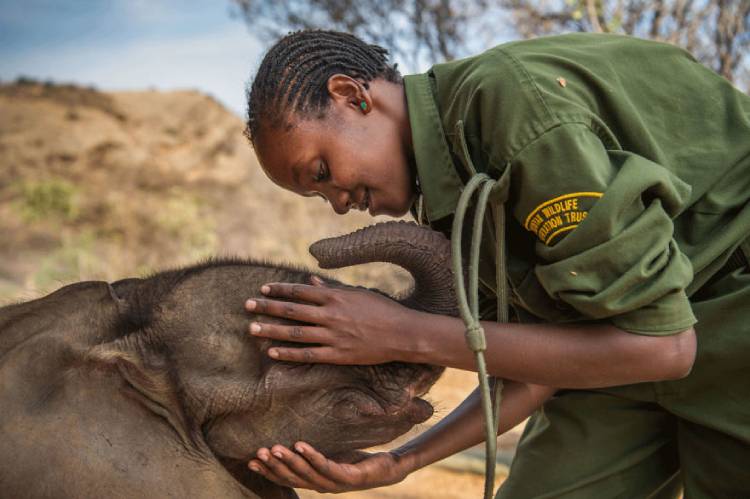
Traditionally, Samburu women in northern Kenya marry at a young age with no education and no chance of having a job. But Sascha Dorothy Levokodok, the first woman to work as a keeper at the Reteti Elephant Sanctuary, is trying to change that tradition. This sanctuary is located in the Mathews Mountains. Although she and the other women who work for her face a lot of opposition, the team at the Reteti Sanctuary share a common goal of rescuing baby elephants, nursing them back to health, and then releasing them back into the wild. returns
What they do is full time, and these cares are done at all hours of the day and night; But despite the difficulty of the work, Levokodok knows no boundaries to achieve his dream and save baby elephants that weigh more than 200 pounds. In a world where we focus only on factors and challenges that separate and limit us, it is essential to think about solutions to remove obstacles.
Most of this photography competition’s winners were photographers at the peak of their careers. However, novice photographers should not despair. One of the winners this year was a novice photographer who took a photo in the best position and angle.
Rubinstein also announced that he had launched a contest for emerging and young photographers called the BigPicture Emerging Photographer Grant to encourage them to work on sustainable projects. The winners’ names of this competition will be announced at the end of July.
5. Terrestrial Wildlife Winner: Cheetah Hunting in the Maasai Mara – Photographer: Yi Lui

Although cheetahs are the fastest animals on earth, hunting is not easy. In fact, in the treeless savannah region of Africa, antelopes and other species can easily see predators approaching, making it difficult for hunters.
Cheetahs lie on the ground so their prey does not notice their presence, and because their skin is the same color as the earth, they hide from the game. When they are within 60 meters of their game, they quickly attack and run up to 95 km/h in a few seconds.
Of course, these predatory animals must also consider the speed of their prey. This type of mountain goat that you see in the photo above can run at a rate of more than 80 km/h. In this photo, the cheetah arrived late and only managed to catch the prey’s leg when it was running away, which shows that sometimes the strategy of the attack is as important as the speed.
Rubinstein, the sponsor of this competition, said:
“Fortunately, the spread of the coronavirus has not affected this series of competitions much. The competition time ended on March 1, which was the beginning of the Corona epidemic. But the judging was done a few months later by photo editors and famous international photographers.
According to him, judging the BigPicture competition usually takes place in the fall, which lasts for two weeks and may interfere with their travel schedule in the wild and where there is no internet. But this year, all the judges were at home and had a lot of time and check the photos more carefully than in previous years.
6. Aquatic Finalist: Green Iguana – Photographer: Lorenzo Mitiga
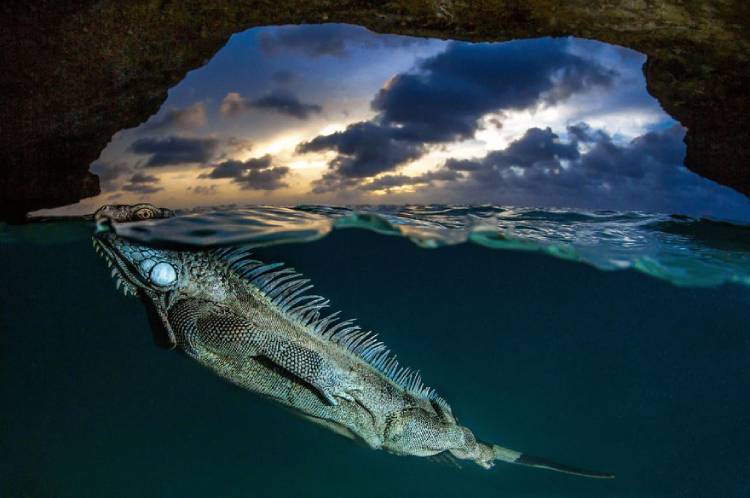
Lorenzo Mitiga was a finalist in the aquatics category. He, who is a member of the Your Shot community of Biographical Magazine, wrote:
I was preparing the camera, its underwater equipment, and the wide lens to capture the last moments of the sunset. At this time, the iguana was swimming in the water above me and at the cave entrance. It was as if he was greeting me.
7. Illustrated Story Section: Coexistence of Guardian Warriors – Photographer: Amy Vitali
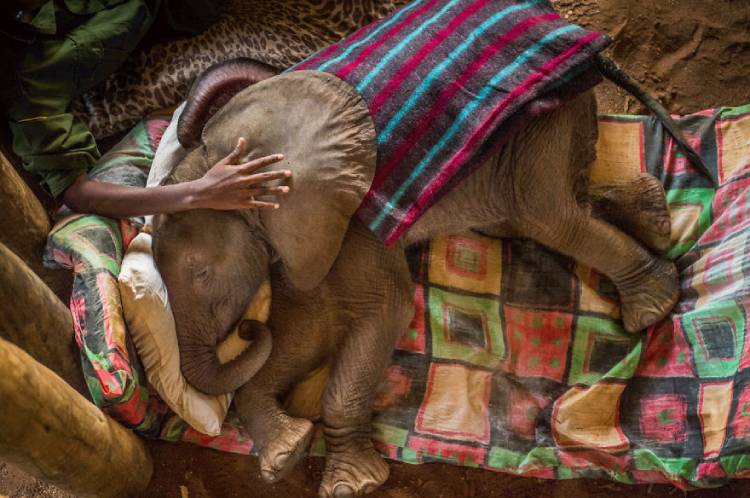
8. Aquatic category finalist: Dancer – Photographer: Hong Kai
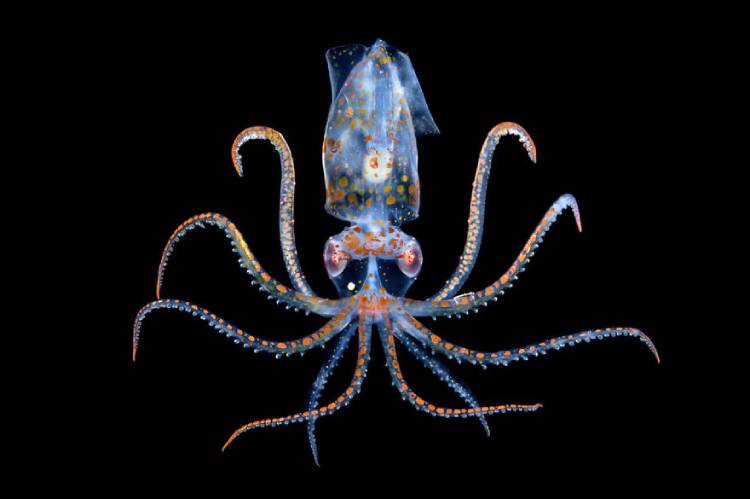
9. Illustrated Story Section: Coexistence, Supporting Warriors – Photographer: Amy Vitali

A ranger at the Lewa Wildlife Sanctuary in Kenya is petted by an 18-month-old black rhino named Kilifi. This rhino has been under care along with two other small rhinos.
10. Landscapes, Seascapes, and Plants Finalist: Rain Visitors at Sunset – Photographer: Agorastos Papatsanis
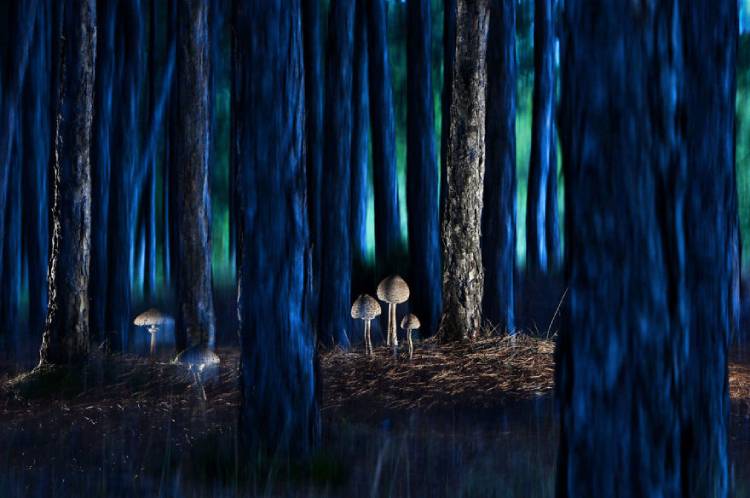
In the spiritual appearance of the photo above, Parasol edible mushrooms may not arouse the viewer’s imagination and do not seem strange. Still, it should be noted that these mushrooms have magical power. TFrom helping trees grow to produce an anticancer metabolic substance, these mushrooms have extraordinary abilities that scientists have just discovered. In fact, the more we know about mushrooms, the more we realize their wonder.
As one of the primary decomposers on Earth, fungi break down the organic matter of dead animals and plants. Therefore, these plants are rich in minerals and nutrients and bring antioxidant, antimicrobial, and anticancer benefits to humans. In addition, with this ability, mushrooms also play a role as environmental modifiers and absorb toxins and heavy metals that have been dumped into the soil by industries.
11- Winner of the Aquatics category: Frozen Mobile House – Photographer: Greg Lecour
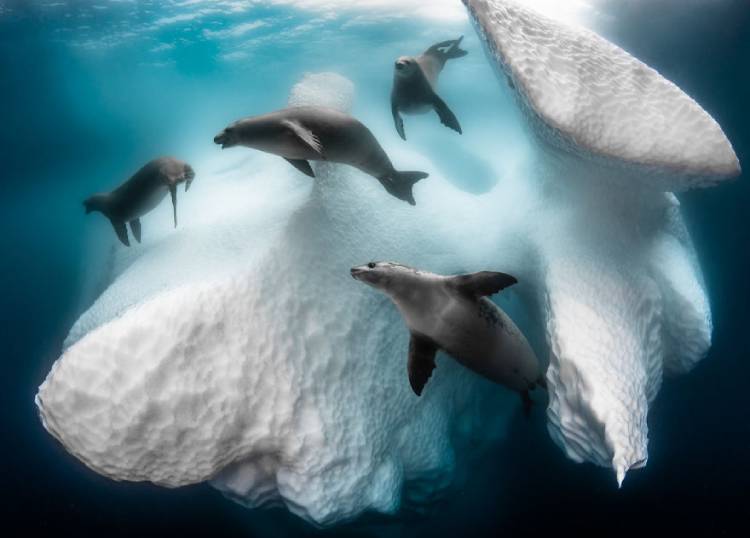
Greg Lecour is a French photographer who went under the frozen waters of Antarctica to photograph this rare sight and encountered several crab-eating jaws. Despite being lazy on land, crab-eaters are agile swimmers and live their entire lives in the Antarctic ice zone.
Floating ice masses by polar currents break the natural glaciers, and in this way, minerals and nutrients go from the land to the ocean. Once in the water, these crushed icicles slowly melt, releasing vital nutrients to provide shelter and food for the crab-eating jaws. Earlier in the water, the nutrients create phytoplankton, which is absorbed by krill (a type of invertebrate), which are the jaws’ favorite food.
12. Winged creatures category winner: A sip of water – photographer: Piotr Naskerki
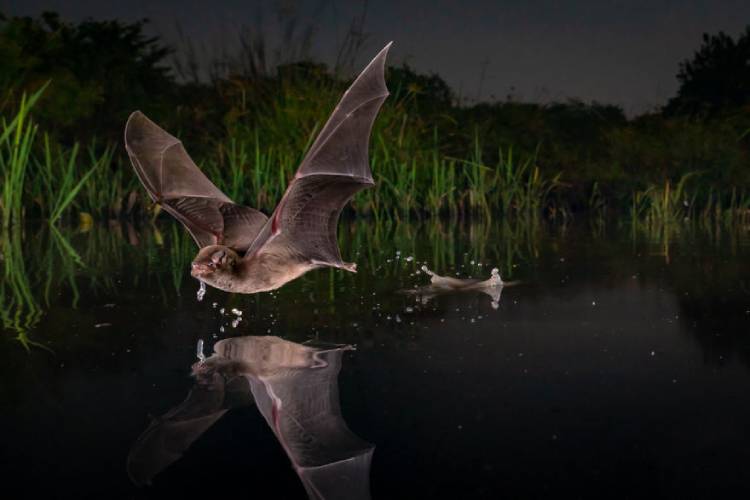
In Gorongosa National Park in Africa, the state of the waters changes with the seasonal changes. In winter, rivers and lakes are full of water, but when summer comes, their water level drops, and they become smaller than the size of a hole. Many species, including Mozambique bats, travel long distances in the summer for a few sips of water.
Considering that the heating and dryness of the earth are increasing, the water springs needed by bats are drying up. If there is not enough water, healthy bats become weaker and sicker. Sometimes bats are forced to drink from artificial water to survive, But the problem is that these bats carry infectious diseases that may spread to people who drink water from those sources. In this situation, viral diseases such as Corona and Ebola spread.
13. Landscapes, Seascapes, and Plants Finalist: Caddo Lake – Photographer: Mauro Battistelli
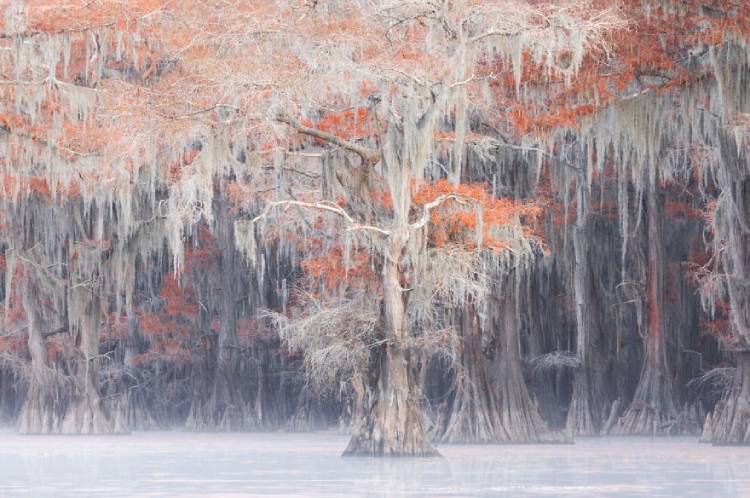
14. Human/Nature Finalist: Kitchen Elephant – Photographer: Gunter DeBruine
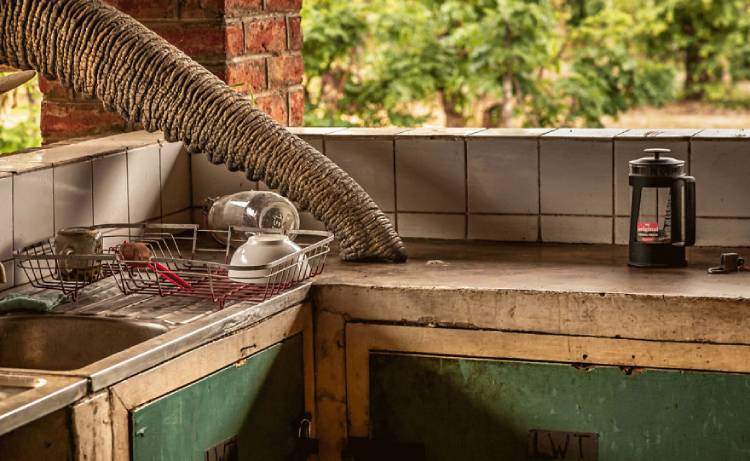
An African savannah elephant came to this windowless kitchen in Malawi’s Kasongo Park after unsuccessfully trying to find food. Gunter DeBruine photographed this subject while the elephant was looking for food. He, both a photographer and a biologist, said that many elephants had done this during his stay at this research site. Of course, Debrevina adds that the species of elephants in Kasongo are hazardous. According to him and other scientists, elephants become aggressive in areas with a lot of poaching.
In 1977, more than 1,000 elephants lived in Kasongo, but in 2015, their number was reduced to 50. The number of elephants in this area has increased to more than 80. Still, it must be said that improving conditions and recovery, especially for intelligent and long-lived animals like elephants, takes time. Establishing bans on the ivory trafficking of these elephants may help in eliminating this critical situation.
15. Terrestrial Wildlife Finalist: Yee Yee in May – Photographer: Amy Vitali
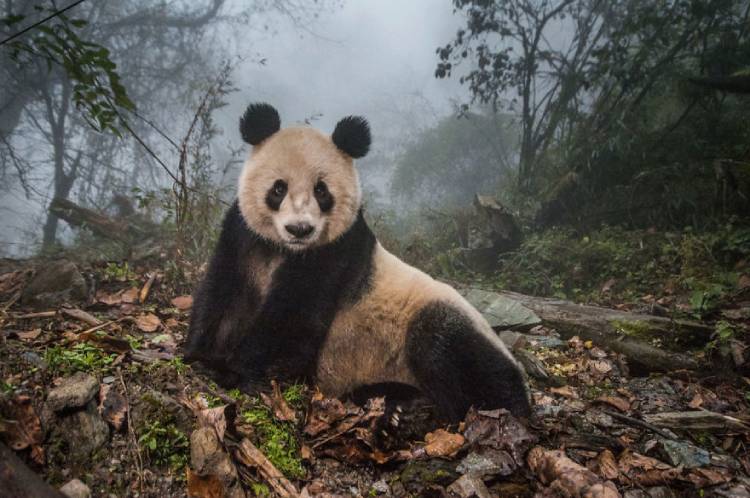
Amy Vitali photographed the 16-year-old panda, Yi Yi, as he strolled in May. The name of this panda was chosen for the peace between China and Japan. Vitaly said about this photo:
This big black and white panda pose like a model and comes for a moment and then suddenly disappears after the photo. Pandas are good at disappearing!
16. Winged creatures finalist: bee-eaters and agave – photographer: Salvador Colove Nibat
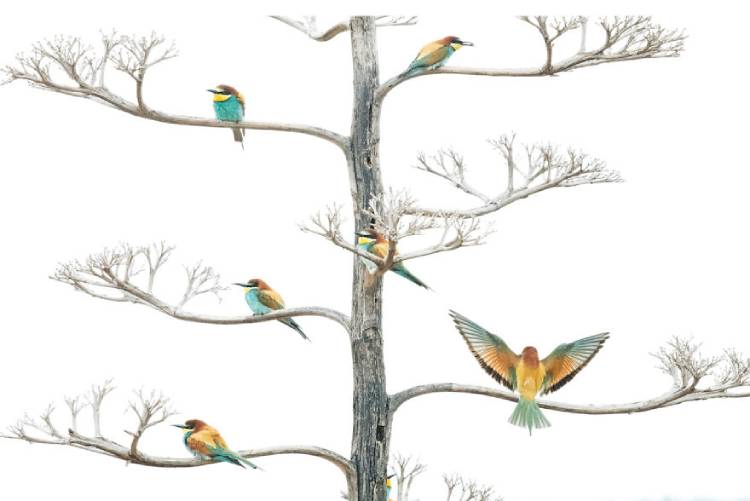
17. Finalist in Aquatics: Friendly Outing – Photographer: Paolo Viana
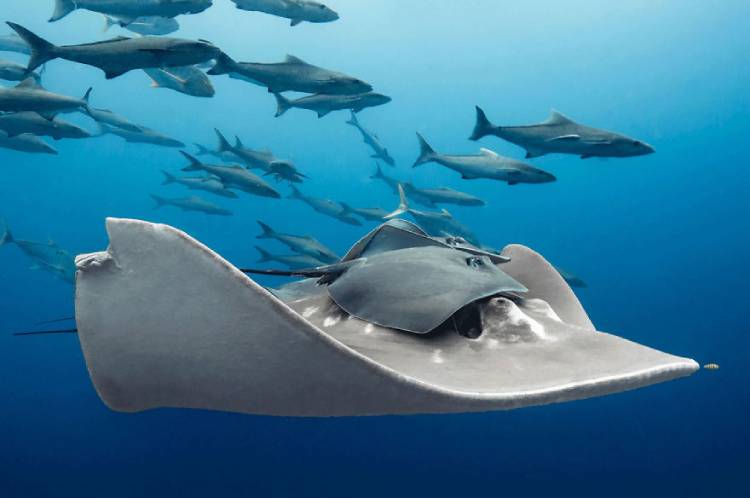
Aquatic “pink bite fish” rides on the fish table in the sea. Bitefish do this to protect themselves from predators, save their energy, and eat the leftovers from the fish’s table. This rare subject was photographed at SS Yolanga Harbor in Queensland, Australia.
18. Terrestrial Wildlife Finalist: Queens of the Highlands – Photographer: Juan Jesus González Ahumada

19. Finalist in Landscapes, Seascapes, and Plants category: “Bajiaozhai Park – Photographer: Xiaoyong Shi
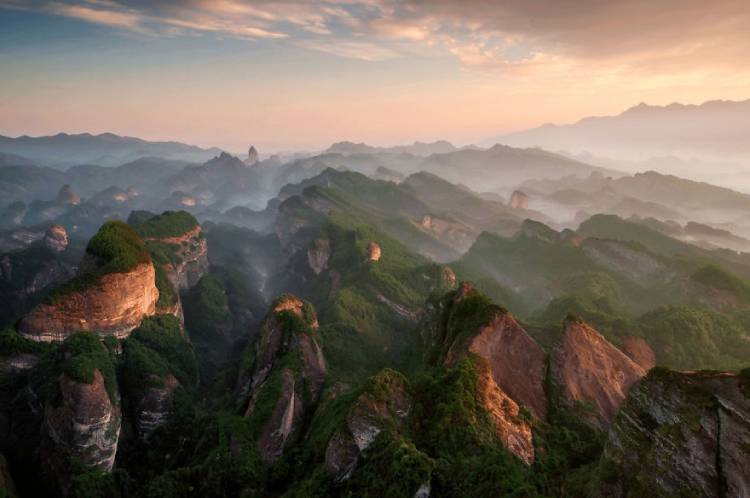
Bajiaozhai National Forest Park is located in Guangxi, China. This park has high ground, unusual topography, mountain climate features, and Danxia mountains. Before sunrise, Xiaoyong Shi climbed the mountain roads for more than an hour to reach the top of the peak and take this beautiful picture in the light.
20. Terrestrial Wildlife Finalist: Hidden Autumn – Photographer: Emanuel Bigi
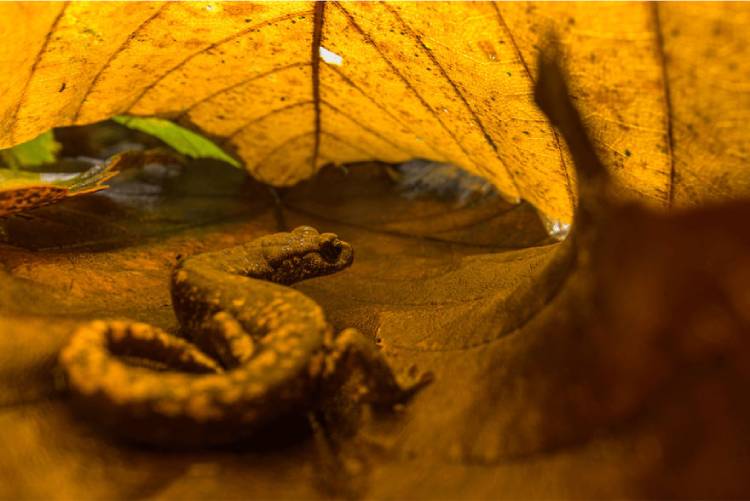
21. Landscapes, Seascapes, and Plants Finalist: Lilies in the Sunlight – Photographer: Henley Spears

22. Winged Creatures Finalist: Camouflage Among Ferns – Photographer: Ruben Perez Novo
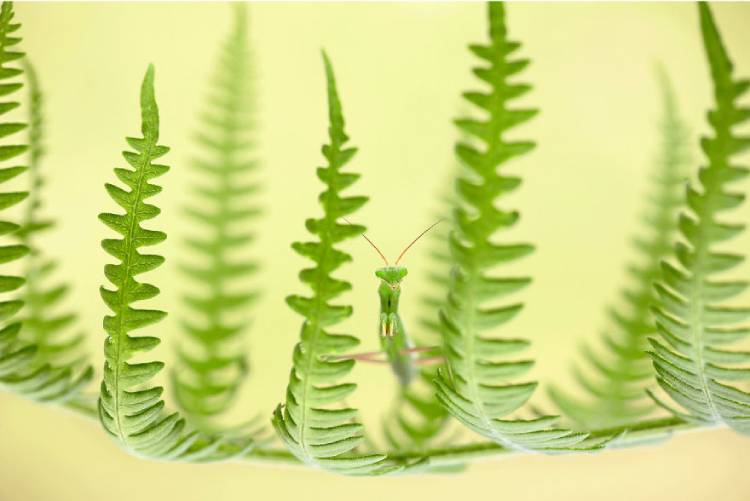
23. Winged Creatures Finalist: The Blue Room – Photographer: David Meron
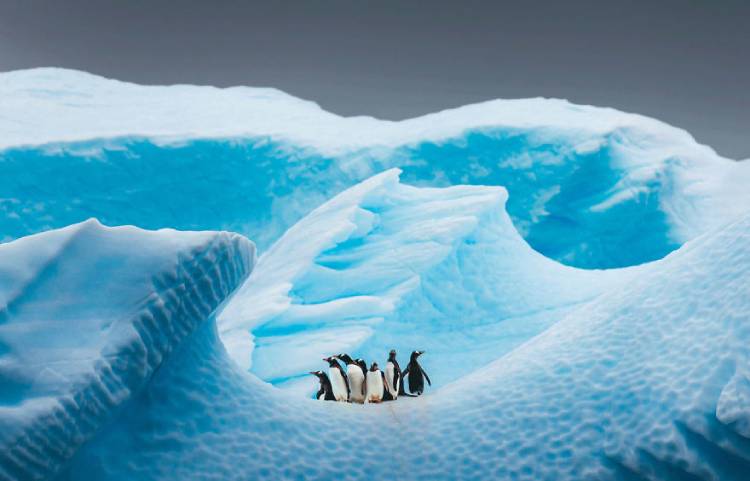
24. Illustrated Story Section: Coexistence, Guardian Warriors – Photographer: Amy Vitali
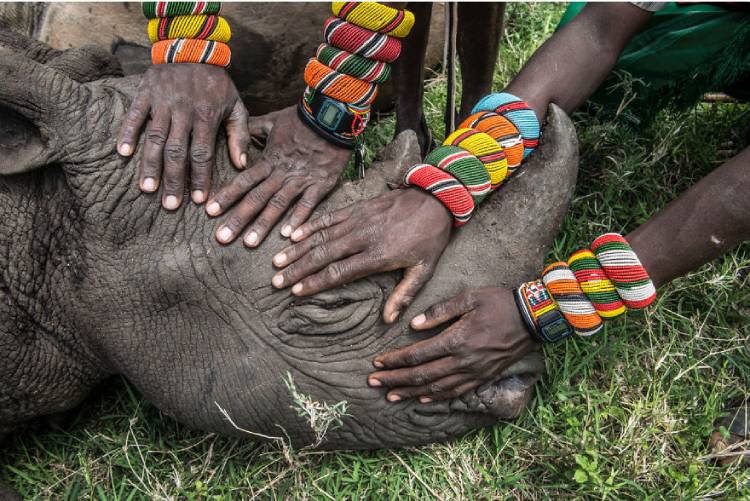
25. Man/Nature Category Finalist: Jungle Man – Photographer: Thomas Vijayan
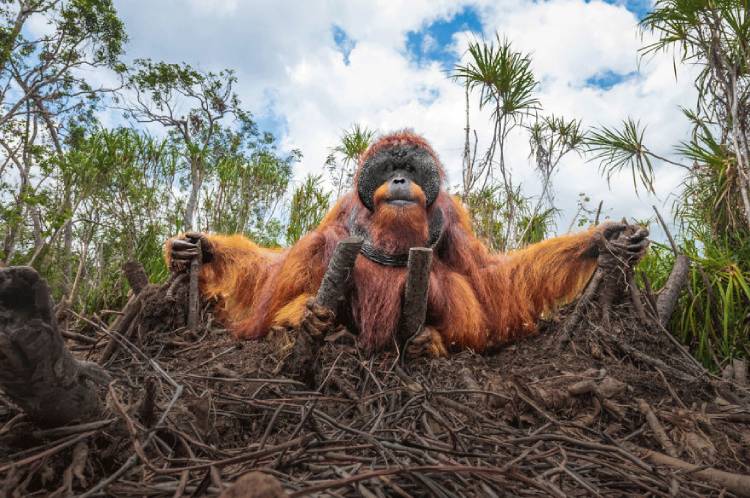
26. Aquatic category finalist: Jellyfish – Photographer: Galis Hovaro
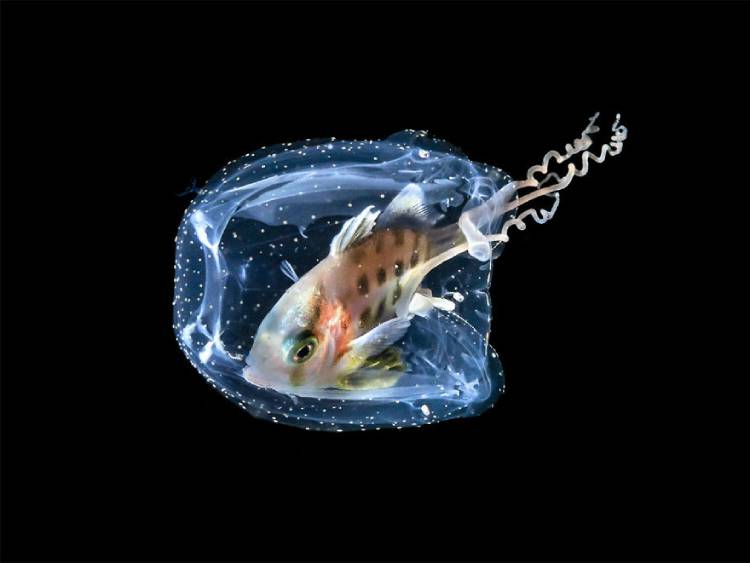
27. Terrestrial Wildlife Finalist: Bad Bear – Photographer: John Langland
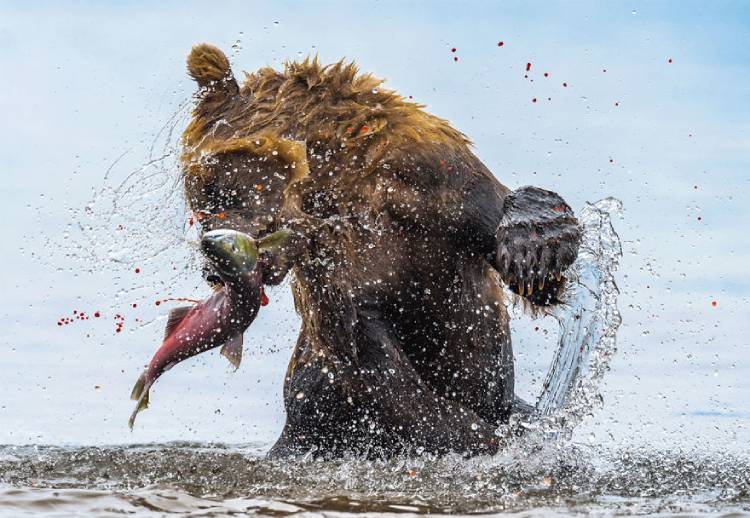
28. Terrestrial Wildlife Finalist: A group of hippopotamus from a high angle – Photographer: Taleb Al-Amari
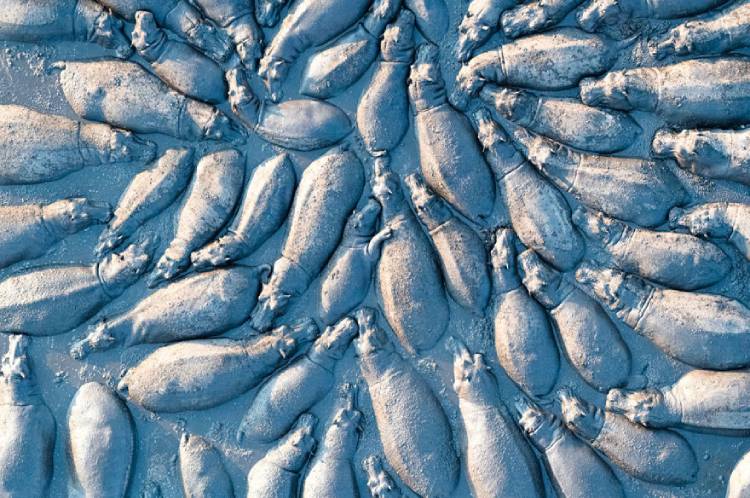
The Okavango River is located in the country of Botswana in Africa. Every winter, the water level of this river crosses its delta, and an array of wildlife gather there to drink and bathe. Due to the drought affecting the lives of humans and animals, this seasonal wetland became more critical in 2019. Animal species, including cows, elephants, and crocodiles, competed for access to the depleting waters of the pond delta.
Among these animals, there were hippopotami. The location of nose and eyes of these semi-aquatic herbivores helps them stay in the water for hours. They are also skilled swimmers and can hold their breath underwater for up to five minutes. But their aquatic skills could not help them in last year’s dry and muddy delta. At this time, at least 200 hippopotamuses were stuck in the mud and rescued with the help of Botswana wildlife officials and water transfer to these deltas. As the Earth warms, such drought crises may increase in Africa.
29. Nature Art Finalist: Lake of Colors – Photographer: Jess Stackhouse
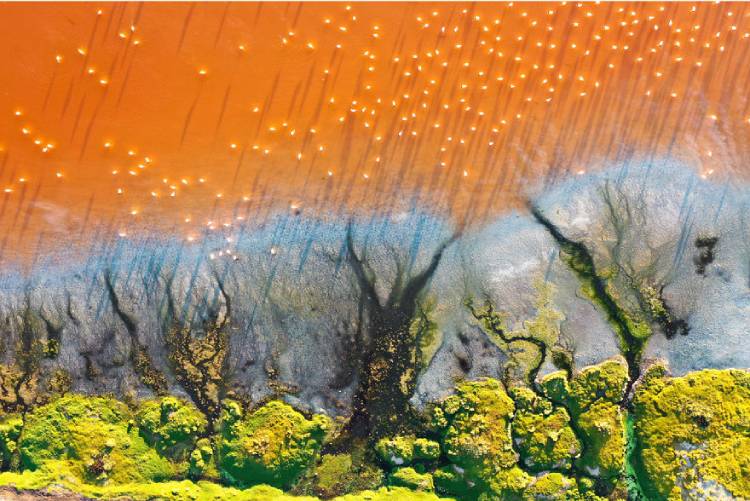
30. Nature Art Finalist: Mount Fuji – Photographer: Mohammad Alkatan
